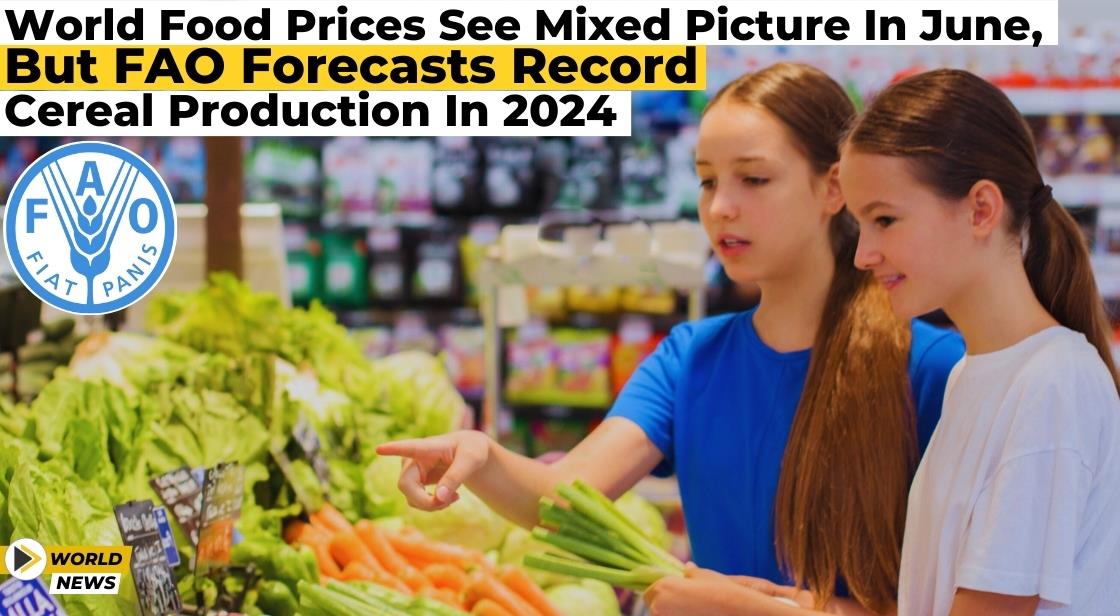World Food Prices See Mixed Picture in June, But FAO Forecasts Record Cereal Production in 2024

News Synopsis
The Food and Agriculture Organization (FAO) of the United Nations reported that global food prices remained relatively stable in June. This stability comes despite some fluctuations within different food categories.
FAO Food Price Index Holds Steady After Decline
According to the FAO's Food Price Index, which tracks prices of major food commodities traded internationally, the index averaged 120.6 points in June. This figure remained unchanged from the revised May data (initially reported at 120.4 points).
The June index reflects a continued decline from its peak of 160.3 points reached in March 2022, following Russia's invasion of Ukraine. Currently, the index sits 2.5% lower compared to June 2023 and a significant 24.8% below its all-time high.
Cereal Prices Fall on Improved Production Prospects
Cereal prices, a significant component of the index, witnessed a 3.0% decrease in June compared to May. This decline is attributed to slightly improved production prospects in major exporting countries like Kazakhstan and Ukraine. Additionally, larger-than-anticipated maize production in Argentina and Brazil further contributed to the drop in cereal prices.
Dairy, Sugar, and Vegetable Oil Prices Rise
While cereal prices dipped, other categories within the index saw price increases. The Food and Agriculture Organization (FAO) reported a 1.2% rise in dairy product prices in June compared to May. Sugar prices also climbed by 1.9%, partly due to lower-than-expected harvests in Brazil.
Vegetable oil prices experienced the most significant increase, jumping 3.1% in June. This rise is driven by higher quotations for palm, soy, and sunflower oils. Meat prices, however, remained relatively stable with slight fluctuations between different types of meat.
FAO Raises Global Cereal Production Forecast for 2024
In a separate report, the FAO revised its global cereal production forecast for 2024 upwards by 7.9 million metric tons (0.3%). This adjustment puts the new forecast at a record high of 2.854 billion tons, surpassing 2023 levels. The increase is primarily due to improved prospects for coarse grains, particularly with anticipated higher maize harvests in Argentina and Brazil.
The FAO also forecasts global cereal utilization to reach 2.856 billion tons in the 2024/25 period, representing a 0.5% increase compared to 2023/24. World cereal stocks by the close of seasons in 2025 are projected to reach 894 million tons.
The FAO's report paints a complex picture of the global food price landscape in June 2024. While there's a sense of cautious optimism with a projected record cereal production for the year, price fluctuations within different food categories persist. This highlights the ongoing challenges in achieving complete food price stability.
Here are some potential takeaways from this report:
-
Improved production prospects for cereals, particularly maize in key exporting countries, offer some relief regarding food security.
-
Rising prices for dairy, sugar, and vegetable oils indicate potential areas of concern that require monitoring.
-
The FAO's forecasts provide valuable insights for policymakers and stakeholders working towards ensuring global food security.
Overall, the report underscores the need for continued efforts to enhance food production efficiency, diversify food sources, and mitigate factors that contribute to price volatility in the global food market.









